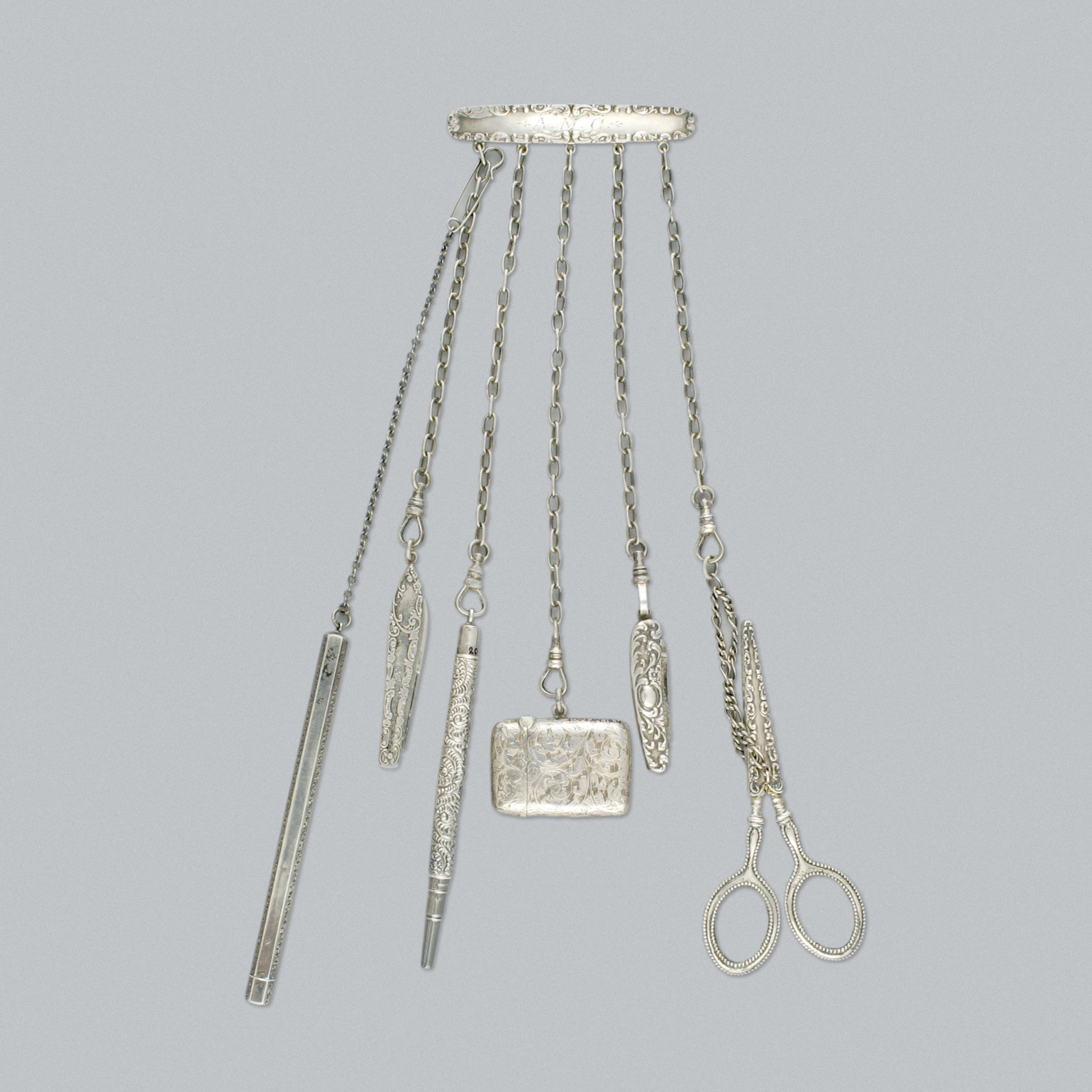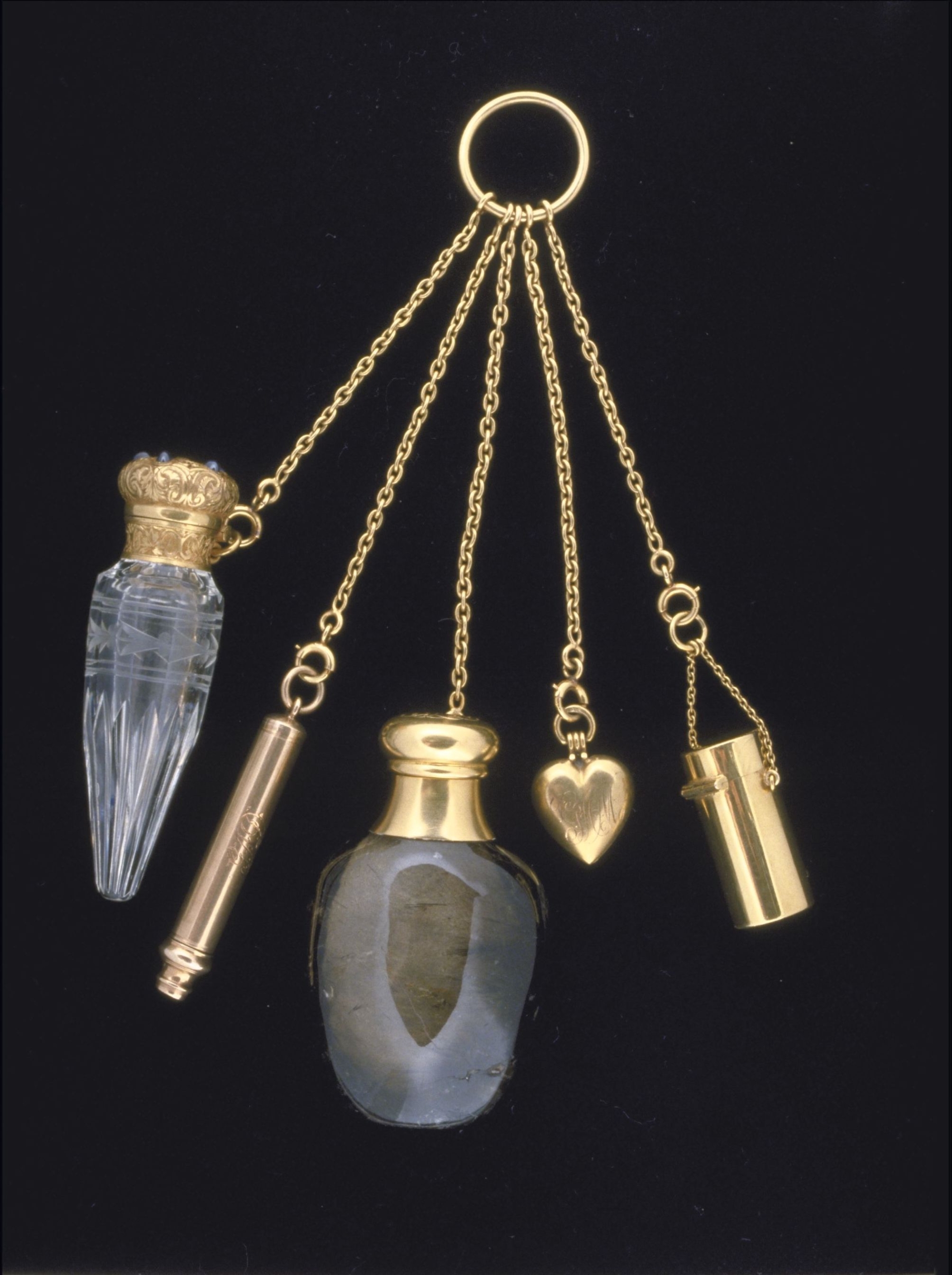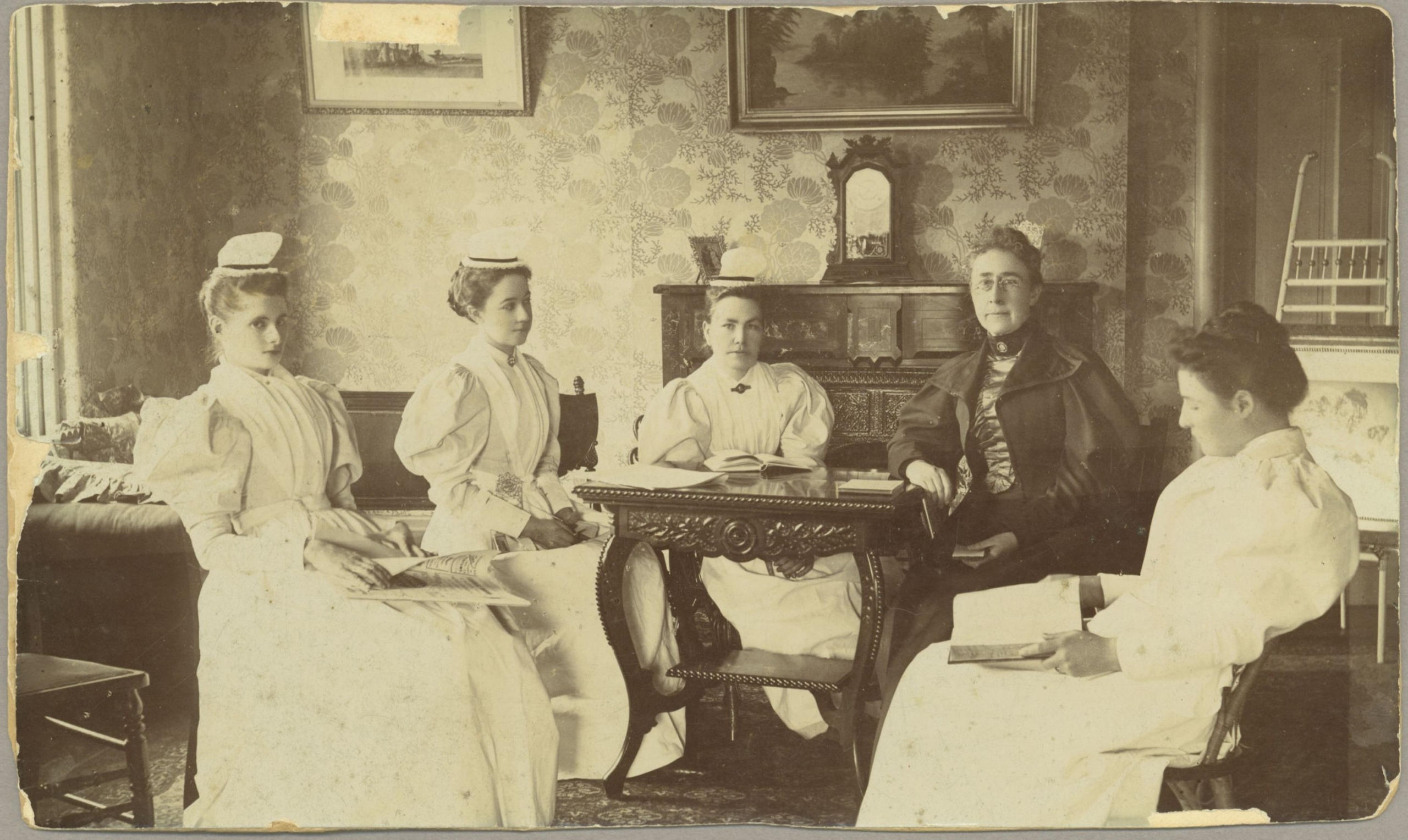Chatelaine
Artifact
Image
Video
Audio
 Activities
Activities
LOOK
Look closely at this object. What do you think its purpose is? Verify your answer by reading the Historical Context below.
DO
Chatelaines were often very personal and included tools to serve specific functions. Design your own chatelaine to assist you in your life. What would you include? Explain your choices to a partner.
Details
 Materials
Materials - Silver
Historical Context
Choose one of the three levels below to match your needs.
- This is a chatelaine. It was made up of several small tools that women would use on daily basis — like a Victorian era Swiss Army Knife.
- Chatelaines were decorative yet functional, often containing a pouch to hold small items, as well as other useful tools: a thimble, a whistle, a pair of scissors and a buttonhook.
- This one was used by a nurse. It is from the Toronto General Hospital Training School of Nursing, which was established in April 1881.
Scroll through the media carousel above to see a picture of another chatelaine from the Museum’s collection and a photograph of a woman wearing a chatelaine.
This is a chatelaine, which can be thought of as the Victorian era’s Swiss Army Knife for women, as it was made up of several small tools that women would use on a daily basis.
Chatelaines were decorative yet functional, often containing a pouch to hold small items, as well as other useful tools. While some women made their own chatelaines from items found around the home, jewellery companies such as Tiffany & Co. and Lalique produced more elaborate ones.
This one was used by a nurse. It is from the Toronto General Hospital Training School of Nursing, which was established in April 1881. This chatelaine is part of the Canadian Nursing History Collection.
This is a chatelaine, which was a little like the Victorian era’s Swiss Army Knife for women. It included several small tools that women might use on a daily basis.
Chatelaines were decorative yet functional, often containing a pouch to hold small items, as well as other useful tools: a thimble, a whistle, a pair of scissors and a buttonhook. Although some women made their own chatelaines from items found around the home, jewellery companies such as Tiffany & Co. and Lalique produced more elaborate versions.
Chatelaines were usually made of white metal, although steel, silver and gold were also used, depending on the wealth and status of the owner. Some chatelaines had up to 13 tools, but most had around five.
They could be specialized to feature the tools that an individual woman might use most. This one, for example, was used by a nurse. It is from the Toronto General Hospital Training School of Nursing, which was established in April 1881.
This object is part of the Canadian Nursing History Collection. The collection is a rich repository of artifacts and documents housed at the Canadian Museum of History, the Canadian War Museum, and Library and Archives Canada. It is the most significant collection of its kind, and consists of approximately 1,800 artifacts from the late 19th century to the 1980s, including nursing uniforms, school pins, equipment, educational materials, paintings, war medals and memorabilia, all of which were used by nursing leaders, nursing sisters and regular nurses alike.
- This is a chatelaine. It was made up of several small tools that women would use on daily basis — like a Victorian era Swiss Army Knife.
- Chatelaines were decorative yet functional, often containing a pouch to hold small items, as well as other useful tools: a thimble, a whistle, a pair of scissors and a buttonhook.
- This one was used by a nurse. It is from the Toronto General Hospital Training School of Nursing, which was established in April 1881.
Scroll through the media carousel above to see a picture of another chatelaine from the Museum’s collection and a photograph of a woman wearing a chatelaine.
This is a chatelaine, which can be thought of as the Victorian era’s Swiss Army Knife for women, as it was made up of several small tools that women would use on a daily basis.
Chatelaines were decorative yet functional, often containing a pouch to hold small items, as well as other useful tools. While some women made their own chatelaines from items found around the home, jewellery companies such as Tiffany & Co. and Lalique produced more elaborate ones.
This one was used by a nurse. It is from the Toronto General Hospital Training School of Nursing, which was established in April 1881. This chatelaine is part of the Canadian Nursing History Collection.
This is a chatelaine, which was a little like the Victorian era’s Swiss Army Knife for women. It included several small tools that women might use on a daily basis.
Chatelaines were decorative yet functional, often containing a pouch to hold small items, as well as other useful tools: a thimble, a whistle, a pair of scissors and a buttonhook. Although some women made their own chatelaines from items found around the home, jewellery companies such as Tiffany & Co. and Lalique produced more elaborate versions.
Chatelaines were usually made of white metal, although steel, silver and gold were also used, depending on the wealth and status of the owner. Some chatelaines had up to 13 tools, but most had around five.
They could be specialized to feature the tools that an individual woman might use most. This one, for example, was used by a nurse. It is from the Toronto General Hospital Training School of Nursing, which was established in April 1881.
This object is part of the Canadian Nursing History Collection. The collection is a rich repository of artifacts and documents housed at the Canadian Museum of History, the Canadian War Museum, and Library and Archives Canada. It is the most significant collection of its kind, and consists of approximately 1,800 artifacts from the late 19th century to the 1980s, including nursing uniforms, school pins, equipment, educational materials, paintings, war medals and memorabilia, all of which were used by nursing leaders, nursing sisters and regular nurses alike.
Summary
- This is a chatelaine. It was made up of several small tools that women would use on daily basis — like a Victorian era Swiss Army Knife.
- Chatelaines were decorative yet functional, often containing a pouch to hold small items, as well as other useful tools: a thimble, a whistle, a pair of scissors and a buttonhook.
- This one was used by a nurse. It is from the Toronto General Hospital Training School of Nursing, which was established in April 1881.
Scroll through the media carousel above to see a picture of another chatelaine from the Museum’s collection and a photograph of a woman wearing a chatelaine.
Essential
This is a chatelaine, which can be thought of as the Victorian era’s Swiss Army Knife for women, as it was made up of several small tools that women would use on a daily basis.
Chatelaines were decorative yet functional, often containing a pouch to hold small items, as well as other useful tools. While some women made their own chatelaines from items found around the home, jewellery companies such as Tiffany & Co. and Lalique produced more elaborate ones.
This one was used by a nurse. It is from the Toronto General Hospital Training School of Nursing, which was established in April 1881. This chatelaine is part of the Canadian Nursing History Collection.
In-Depth
This is a chatelaine, which was a little like the Victorian era’s Swiss Army Knife for women. It included several small tools that women might use on a daily basis.
Chatelaines were decorative yet functional, often containing a pouch to hold small items, as well as other useful tools: a thimble, a whistle, a pair of scissors and a buttonhook. Although some women made their own chatelaines from items found around the home, jewellery companies such as Tiffany & Co. and Lalique produced more elaborate versions.
Chatelaines were usually made of white metal, although steel, silver and gold were also used, depending on the wealth and status of the owner. Some chatelaines had up to 13 tools, but most had around five.
They could be specialized to feature the tools that an individual woman might use most. This one, for example, was used by a nurse. It is from the Toronto General Hospital Training School of Nursing, which was established in April 1881.
This object is part of the Canadian Nursing History Collection. The collection is a rich repository of artifacts and documents housed at the Canadian Museum of History, the Canadian War Museum, and Library and Archives Canada. It is the most significant collection of its kind, and consists of approximately 1,800 artifacts from the late 19th century to the 1980s, including nursing uniforms, school pins, equipment, educational materials, paintings, war medals and memorabilia, all of which were used by nursing leaders, nursing sisters and regular nurses alike.



